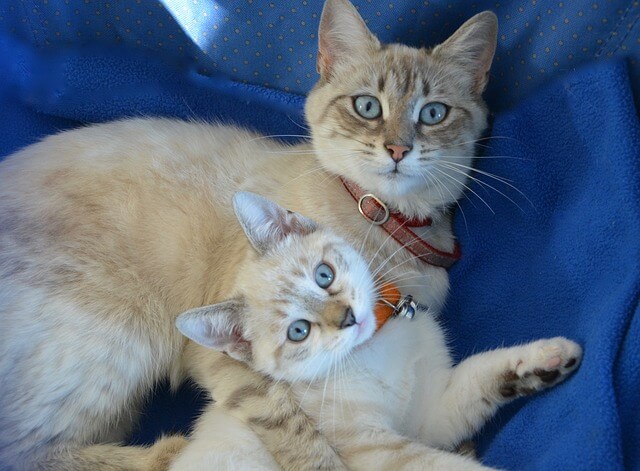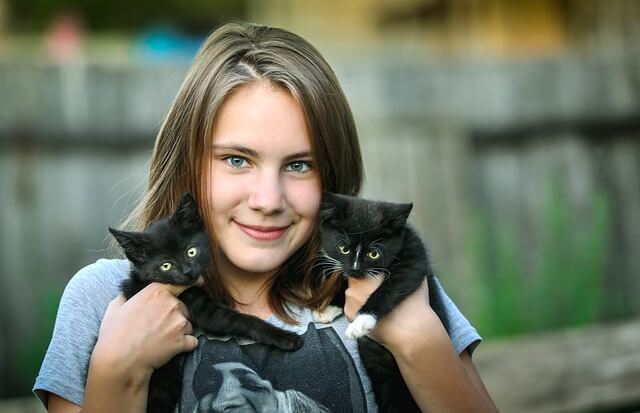Kittens are unchanging characters of many greeting cards. We can tell you why: a picture of tiny, fluffy kittens can give nothing but a feeling of affection. However, we invite you to a slightly more serious subject! Let’s figure out what we better know about cats and especially newborn kittens. In addition, we should see some special facts and ideas how to take care of felines to make them happy and healthy.
We offer the most interesting facts about cats that will affect even the coldest and the most indifferent human being! Let’s feed our brains!
The average weight of newborn kittens.
The newly born kittens weigh about 4 oz (110 grams), then they add 3,5 oz (100 grams) of weight each subsequent week.
In other words, an average four-week-old baby weighs about 16 oz (450 grams). In the future, after reaching the age of six months, the kitten should gain 16 oz (450 grams) per month.
A mother cat gives newborn babies colostrum, which is vital for their health
This happens on the first or second day of life of small kittens. Colostrum contains special antibodies that will allow the kittens to survive in the future, overcome many diseases and grow. Colostrum strengthens the immune system of the kitten, makes it strong enough to withstand all the scourges and infections.
Newborn kittens need warmth.
And not only just warmth! Experts managed to find out precisely: in order to survive, babies need a temperature of about 90 degrees Fahrenheit (32 degrees Celsius). In addition, the kittens need a bit of free space around – when it gets hot, they will stand up and “cool down” a little. Thus, the possibility of overheating is excluded.
Newborn kittens completely depend on the mother.
The babies, who have just been born, have closed eyes and ears! You correctly understood: kittens are born deaf. Eyes open at the age of seven to fourteen days. Kittens are born blue-eyed, but by the age of eight weeks the color of their eyes can “radically” change.
Newborn kittens should often eat.
Newborns should receive milk from their mother every 2-3 hours, which they do very well! But sometimes it is better to feed from a bottle. It is important to ensure that the alimentation intensity (speed) is as close as possible to the natural one. The tummy of the kitten must “look” downward to reduce the risk of so-called aspiration of the liquid. The kitten learns to take solid food at the age of three to four weeks. The process of feeding the kittens should be closely monitored – if they do not eat enough, then can happen a sharp sugar drop in blood, and this is dangerous for the life.
Kittens should get help to go to the toilet
Kittens do not know how to go to the toilet themselves. Thus, their mother prompts them to defecate and urinate. No mom nearby? Then help a little the kitties: take a wet and warm cloth, wipe the anus, simulating the movements of the mother’s tongue.
Kittens get milk teeth at about the age of three weeks.
Did not know? Nevertheless, kittens, as our children, first have milk teeth, which gradually change to permanent by the age of fourteen weeks. By this age they already look like adult cats!
And then the kittens begin to play!
A healthy kitten should be able to stand on its hind legs at the age of about ten days. In twenty-one days the baby should go on its own. Let it hesitate, but it should try walking itself, without outside help! Well, and by four weeks the kitten starts its first games. How funny and extraordinarily cute it becomes!
Kittens are very delicate creatures!
If possible, try to protect both the mother cat and the kittens from all possible and impossible misfortunes. Now we mainly talk about fleas. Be aware that anemia caused by flea bites can kill a healthy eight-week-old kitten. Before your lady-cat is going to give birth, carefully inspect it for fleas.
You can take kitten from the mother when they are eight weeks old
At the age of two months, most of the kittens are already fully prepared for independent living, sufficiently socialized. Do not take kittens at an earlier age, this is fraught with numerous problems of very different kinds.
Cat nose prints are unique, like human fingerprints.
Cats never meow with each other. This sound is especially for people.
The cat’s skeleton consists of 230 bones, which is 24 more than we have.
There are 600 million domestic cats on the earth.
Cats lack normal clavicles. Due to this shortcoming, cats are able to squeeze their bodies through the smallest holes where the cat’s head passes. Perhaps you have seen how a cat checks the hole, where it has to crawl, trying to put its head inside. The average adult cat can climb through a hole, for example, in a fence, with a width of only 4 inches (10 cm).
A cat is a great acrobat. Its front paws can rotate in almost any direction and both halves of its body can move in opposite directions!
Cats have five toes on their forepaws, but on the hind ones only four of them
The cat’s ear does a 180 degree turn. Each cat’s ear has 32 muscles. Meanwhile cat’s hearing is much more sensitive in comparison with human or dog’s one. The cat hears within 65 kHz, whereas the human being can do it only within 20 kHz.
A cat can hear sounds in the ultrasound range, and its “ambush” near the mouse mink makes sense, even if the rodents do not move. Rodents communicate by means of ultrasound, and the cat eavesdrops on these conversations.
There are tactile hairs on the cat’s head and front paws. They help the cat to orientate in open space, without touching obstacles, but sensng them at a distance.
The cat has the largest eyes of all animals in comparison to its body. If the cat was the size of a human, the size of its eyes would reach 1,6 – 2 inches (4-5 cm).
Most cats do not have eyelashes
The eyes of the cats are arranged so that both look in the same direction, just like ours (unlike, for example, dogs) – for us this is a more familiar face type, maybe that’s why we consider cats to be such cute animals?
A cat cannot see in absolute darkness, but its “night vision” is beyond competition. Its eyes have a reflective layer that increases the amount of light that enters the retina.
The normal temperature of the cat’s body is 102 degrees Fahrenheit (38 Celsius)
A cat can have more than 100 kittens for its life. One pair of cats and their descendants in 7 years can produce 420,000 kittens.
In 1952, a striped cat from Texas named Dusty set a new record, it had more than 120 kittens, and the last litter was born when the lady-cat was 18 years old.
The largest litter (with all the surviving kittens) recorded in South Africa. The Persian cat called Bluebell gave birth to 14 kittens! The maximum number of kittens in the litter has been 19.
And finally … cats are just cute creatures! Are you agree, aren’t you?








